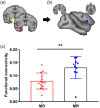Abnormality of anxious behaviors and functional connectivity between the amygdala and the frontal lobe in maternally deprived monkeys
- PMID: 37464725
- PMCID: PMC10498070
- DOI: 10.1002/brb3.3027
Abnormality of anxious behaviors and functional connectivity between the amygdala and the frontal lobe in maternally deprived monkeys
Abstract
Objective: Anxious behaviors often occur in individuals who have experienced early adversity. Anxious behaviors can bring many hazards, such as social withdrawal, eating disorders, negative self-efficacy, self-injurious thoughts and behaviors, anxiety disorders, and even depression. Abnormal behavior are is closely related to changes in corresponding circuit functions in the brain. This study investigated the relationship between brain circuits and anxious behaviors in maternal-deprived rhesus monkey animal model, which mimic early adversity in human.
Methods: Twenty-five rhesus monkeys (Macaca mulatta) were grouped by two different rearing conditions: 11 normal control and mother-reared (MR) monkeys and 14 maternally deprived and peer-reared (MD) monkeys. After obtaining images of the brain areas with significant differences in maternal separation and normal control macaque function, the relationship between functional junction intensity and stereotypical behaviors was determined by correlation analysis.
Results: The correlation analysis revealed that stereotypical behaviors were negatively correlated with the coupling between the left lateral amygdala subregion and the left inferior frontal gyrus in both MD and MR macaques.
Conclusion: This study suggests that early adversity-induced anxious behaviors are associated with changes in the strength of the amygdala-prefrontal connection. The normalization of the regions involved in the functional connection might reverse the behavioral abnormality. It provides a solid foundation for effective intervention in human early adversity.
Significance statement: This study suggests that early adversity-induced anxious behaviors are associated with changes in the strength of the amygdala-prefrontal connection. The higher the amygdala-prefrontal connection strength, the less stereotyped behaviors exhibited by monkeys experiencing early adversity. Thus, in the future, changing the strength of the amygdala-prefrontal connection may reverse the behavioral abnormalities of individuals who experience early adversity. This study provides a solid foundation for effective intervention in humans' early adversity.
Keywords: amygdala-prefrontal connection; anxious behaviors; brain circuits; maternal deprivation; rhesus monkeys.
© 2023 The Authors. Brain and Behavior published by Wiley Periodicals LLC.
Conflict of interest statement
The authors declare no conflicts of interest.
Figures





Similar articles
-
Early adversity contributes to chronic stress induced depression-like behavior in adolescent male rhesus monkeys.Behav Brain Res. 2016 Jun 1;306:154-9. doi: 10.1016/j.bbr.2016.03.040. Epub 2016 Mar 26. Behav Brain Res. 2016. PMID: 27025444
-
The international society for developmental psychobiology Sackler symposium: early adversity and the maturation of emotion circuits--a cross-species analysis.Dev Psychobiol. 2014 Dec;56(8):1635-50. doi: 10.1002/dev.21260. Epub 2014 Oct 7. Dev Psychobiol. 2014. PMID: 25290865 Free PMC article. Review.
-
Amygdala gene expression correlates of social behavior in monkeys experiencing maternal separation.J Neurosci. 2007 Mar 21;27(12):3295-304. doi: 10.1523/JNEUROSCI.4765-06.2007. J Neurosci. 2007. PMID: 17376990 Free PMC article.
-
Hydroxymethylation and DNA methylation profiles in the prefrontal cortex of the non-human primate rhesus macaque and the impact of maternal deprivation on hydroxymethylation.Neuroscience. 2014 May 30;268:139-48. doi: 10.1016/j.neuroscience.2014.03.021. Epub 2014 Mar 19. Neuroscience. 2014. PMID: 24657458 Free PMC article.
-
Sex Differences in Affective Dysfunction and Alterations in Parvalbumin in Rodent Models of Early Life Adversity.Front Behav Neurosci. 2021 Nov 4;15:741454. doi: 10.3389/fnbeh.2021.741454. eCollection 2021. Front Behav Neurosci. 2021. PMID: 34803622 Free PMC article. Review.
References
-
- Almada, R. C. , Coimbra, N. C. , & Brandão, M. L. (2015). Medial prefrontal cortex serotonergic and GABAergic mechanisms modulate the expression of contextual fear: Intratelencephalic pathways and differential involvement of cortical subregions. Neuroscience, 284, 988–997. 10.1016/j.neuroscience.2014.11.001 - DOI - PubMed
-
- Bessa Ferreira, V. H. , Cadorio Da Silva, C. P. , Fonseca, E. D. P. , Correia Santos Das Chagas, A. C. , Mesquita Pinheiro, L. G. , De Almeida, R. N. , Sousa, M. B. C. D. , Silva, H. P. A. D. , Galvão‐Coelho, N. L. , & Ferreira, R. G. (2018). Hormonal correlates of behavioural profiles and coping strategies in captive capuchin monkeys (Sapajus libidinosus). Applied Animal Behaviour Science, 207, 108–115. 10.1016/j.applanim.2018.07.002 - DOI
Publication types
MeSH terms
LinkOut - more resources
Full Text Sources
Medical

